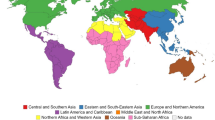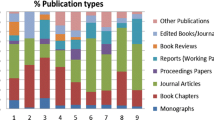Abstract
Argentina´s patterns of publication in the humanities and social sciences were studied for the period 2003–2012, using the Scopus database and distinguishing the geographic realm of the research. The results indicate that “topics of national scope” have grown and gained international visibility. They can be broadly characterized as having Spanish as the language of publication, and a marked preference for single authorship; in contrast, the publication of “global topics”, not geographically limited, characteristically have English as the language of divulgation, and institutional collaboration is stronger and more consolidated. Citation is apparently not determined only by the geographic realm of research, but also by language of publication, co-authorship, and the profiles of the journals where published. These results could contribute to constructive reflection upon publishing policy. The existence of a community of journals that tolerates biased patterns may make researchers echo and perpetuate poor practices, constructing or adapting the channels of communication. Such results also prove useful as a point of reference when evaluation criteria are elaborated by scientific committees, as unsupervised promotion and evaluation patterns could become based on local or overly subjective precepts, disregarding the disciplinary practices of the international scientific community.














Similar content being viewed by others
Notes
In Spain, the evaluation criteria in the realm of social sciences laid down by the Comisión Nacional Evaluadora de la Actividad Investigadora (CNEAI) specify that the number of authors of a contribution should be justified by the subject matter, its complexity and its extension. In the case of Humanities: “Unless plainly justified by the complexity of the subject matter, the size of the corpus analyzed or the extensión and innovative nature of the contribution, the existence of more than one author can reduce the qualification assigned to it.” (España 2013)
In Argentina, for the case of Social Sciences and the Humanities there exists a preliminary document for evaluation criteria that can be consulted at: http://www.ceil-conicet.gov.ar/divulgacion/articulo-del-mes/criterios-de-evaluacion-de-la-produccion-cientifica-de-las-humanidades-y-ciencias-sociales-ciecehcs-comision-interinstitucional-de-elaboracion-de-criterios-de-evaluacion-para-las-humanidades-y-cie/.
References
Abramo, G., & D’ Angelo, C. A. (2011). Evaluating research: From informed peer review to bibliometrics. Scientometrics, 87(3), 499–514.
Araujo-Ruíz, J. A., Torricella-Morales, R. G., Van Hooydonk, G., & Arencibia-Jorge, R. (2005). Cuban scientific articles in ISI citation indexes and CubaCiencias databases (1988–2003). Scientometrics, 65(2), 161–171.
Bernal, I. (2013). Open access and the changing landscape of research impact indicators: New roles for repositories. Publications, 1(2), 57–77.
Bonfiglioli, A., & Mari, E. (2000). La cooperación científico-tecnológica entre la Unión Europea y América Latina: El actual contexto internacional y el Programa Marco de la Unión Europea. Revista REDES, Buenos Aires, Universidad Nacional de Quilmes, 7(15), 183–208.
Borgman, C. L., & Furner, J. (2002). Scholarly communication and bibliometrics. Annual Review of Information Science and Technology, 36(1), 3–72.
Bornmann, L., & Daniel, H. D. (2008). What do citation counts measure? A review of studies on citing behavior. Journal of Documentation, 64(1), 45–80.
Bornmann, L., Schier, H., Marx, W., & Daniel, H. (2012). What factors determine citation counts of publications in chemistry besides their quality? Journal of Informetrics, 6(1), 11–18.
Cetto, A. M., & Hillerud, K. I. (1995). Publicaciones científicas en América Latina. México: Fondo de Cultura Económica.
Chinchilla-Rodríguez, Z., Benavent-Pérez, M., Miguel, S., & Moya-Anegón, F. (2012a). International collaboration in medical research in Latin America and the Caribbean (2003–2007). Journal of the American Society for Information Science and Technology, 63(11), 2223–2238.
Chinchilla-Rodríguez, Z., López-Illescas, C., & Moya-Anegón, F. (2012b). Biomedical scientific publication patterns in the Scopus database: A case study of Andalusia, Spain. ACIMED: Revista Cubana de Información en Ciencias de la Salud, 23(3), 219–237.
Chinchilla-Rodríguez, Z., Vargas-Quesada, B., Hassan-Montero, Y., González-Molina, A., & Moya-Anegón, F. (2010). New approach to the visualization of international scientific collaboration. Information Visualization, 9(4), 277–287.
Collazo-Reyes, F. (2014). Growth of the number of indexed journals of Latin America and the Caribbean: The effect on the impact of each country. Scientometrics, 98, 197–209.
Collazo-Reyes, F., Luna-Morales, M. E., Russell, J. M., & Pérez-Angón, M. A. (2008). Publication and citation patterns of Latin American and Caribbean journals in the SCI and SSCI from 1995 to 2004. Scientometrics, 75(1), 145–161.
Egghe, L., & Rousseau, R. (2000). Partial orders and measures for language preferences. Journal of the American Society for Information Science, 51(12), 1123–1130.
Engels, T. C. E., Ossenblok, T. L. B., & Spruyt, E. H. J. (2012). Changing publication patterns in the social sciences and humanities, 2000–2009. Scientometrics, 93(2), 373–390.
España, Ministerio de Educación, Cultura y Deporte. Resolución de 15 de noviembre de (2013). de la Comisión Nacional Evaluadora de la Actividad Investigadora, por la que se publican los criterios específicos aprobados para cada uno de los campos de evaluación. Boletín Oficial del Estado, 21 de noviembre de 2013, núm. 279, 92880–92893.
Fedderke, J. W. (2013). The objectivity of national research foundation peer review in South Africa assessment against bibliometric indexes. Scientometrics, 97(2), 177–206.
Fernández-Quijada, D., Masip, P., & Bergillos, I. (2013). El precio de la internacionalidad: La dualidad en los patrones de publicación de los investigadores españoles en comunicación. Revista Española de Documentación Científica, 36(2), 1–19.
Gauffriau, M., Larsen, P. O., & Maye, I. (2007). Publication, cooperation and productivity measures in scientific research. Scientometrics, 73(2), 175–214.
Glänzel, W. (2001). National characteristics in International scientific Co-Authorship relations. Scientometrics, 51(1), 69–115.
Glänzel, W., Debackere, K., Thijs, B., & Schubert, A. (2006). A concise review on the role of author self-citations in information science, bibliometrics and science policy. Scientometrics, 67(2), 263–277.
Gómez, I., Fernández, M. T., Zulueta, M. A., & Camí, J. (1995). Analysis of biomedical research in Spain. Research Policy, 24(3), 459–471.
Guerrero Bote, V. P., Olmeda-Gómez, C., & Moya-Anegón, F. (2013). Quantifying the benefits of international scientific collaboration. Journal of the American Society for Information Science and Technology, 64(2), 392–404.
Katz, J. S., & Martin, B. R. (1997). What is research collaboration? Research Policy, 26(1), 1–18.
Kreimer, P. (2000). Ciencia y periferia: Una lectura sociológica. In: M. Monserrat (Ed.), La ciencia en la Argentina entre siglos. Textos, contextos e instituciones (pp. 187–200). Buenos Aires: Manantial.
Lancho-Barrantes, B. S., Guerrero-Bote, V. P., Chinchilla-Rodríguez, Z., & Moya-Anegón, F. (2012). Citation flows in the zones of influence of scientific collaborations. Journal of the American Society for Information Science and Technology, 63(3), 481–489.
Leimu, R., & Koricheva, J. (2005). What determines the citation frequency of ecological papers? Trends in Ecology & Evolution, 20(1), 28–32.
Leta, J. (2011). Growth of Brazilian science: A real internationalization or a matter of databases’coverage? In E. Noyons, P. Ngulube, & J. Leta (Eds.), Proceedings of 13th international conference of the international society for scientometrics and informetrics (pp. 392–408). Durban: ISSI, Leiden University and University of Zululand.
Luna-Morales, M. E., & Collazo-Reyes, F. (2007). Análisis histórico bibliométrico de las revistas latinoamericanas y caribeñas en los índices de la ciencia internacional 1961–2005. Revista Española de Documentación Científica, 30(4), 523–543.
Michels, C., & Schmoch, U. (2012). The growth of science and database coverage. Scientometrics, 93(3), 831–846.
Miguel, S. (2008). Aproximación cienciométrica al análisis y visualización del dominio científico argentino, 1990–2005. Granada: Universidad de Granada.
Miguel, S. (2011). Revistas y producción científica de América Latina y el Caribe: Su visibilidad en SciELO, RedALyC y SCOPUS. Revista Interamericana de Bibliotecología, 34(2), 187–199.
Miguel, S., & Moya-Anegón, F. (2009). La ciencia argentina bajo la lupa de los indicadores cienciométricos: Una mirada crítica de la realidad científica argentina. La Plata: Ediciones Al Margen.
Molteni, V., & Zulueta, M. A. (2002). Análisis de la visibilidad internacional de la producción científica argentina en las bases de datos Social Sciences Citation Index y Arts and Humanities Citation Index en la década de 1990–2000: Estudio bibliométrico. Revista Española de Documentación Científica, 25(4), 455–465.
Moya-Anegón, F., Chinchilla-Rodríguez, Z., Vargas-Quesada, B., Corera-Álvarez, E., Muñoz-Fernández, F. J., & González-Molina, A. (2007). Coverage analysis of Scopus: A journal metric approach. Scientometrics, 73(1), 53–78.
Moya-Anegón, F., Guerrero-Bote, V., Bormann, L., & Moed, H. (2013). The research guarantors of scientific papers and the output counting: A promising new approach. Scientometrics, 97(2), 421–434.
Ochoa-Henríquez, H. (2004). Visibilidad: El reto de las revistas científicas latinoamericanas. Opción—Universidad De Zulia, 20(43), 162–168.
Osca Lluch, J., & Haba, J. (2005). Dissemination of Spanish social sciences and humanities journals. Journal of Information Science, 31(3), 229–236.
Ossenblok, T. L. B., Verleysen, F. T., & Engels, T. C. E. (2014). Coauthorship of journal articles and book chapters in the social sciences and humanities (2000–2010). Journal of the Association for Information Science and Technology,. doi:10.1002/asi.
Perianes-Rodríguez, A., Chinchilla-Rodríguez, Z., Vargas-Quesada, B., Olmeda-Gómez, C., & Moya-Anegón, F. (2009). Synthetic hybrid indicators based on scientific collaboration to quantify and evaluate individual research results. Journal of Informetrics, 3(2), 91–101.
Rehn, C., & Kronman, U. (2008). Bibliometric handbook for Karolinska Institutet. Karolinska Institutet University Library. Version 1.05.
Rodríguez-Yunta, L., & Giménez-Toledo, E. (2013). Fusión, coedición o reestructuración de revistas científicas en humanidades y ciencias sociales. El profesional de la Información, 22(1), 36–45.
Santa, S., & Herrero, V. (2010). Cobertura de la ciencia de América Latina y el Caribe en Scopus vs Web of Science. Investigación Bibliotecológica, 24(52), 13–27.
Van Leeuwen, T. N., Moed, H. F., Tijssen, R. J. W., Visser, M. S., & Van Raan, A. F. J. (2001). Language biases in the coverage of the Science Citation Index and its consequences for international comparisons of national research performance. Scientometrics, 51(1), 335–346.
Zitt, M., Perrot, F., & Barré, R. (1998). The transition from “National” to “Transnational” model and related measures of countries’ performance. Journal of the American Society for Information Science, 49(1), 30–42.
Acknowledgments
This work was made possible through financing by the Project PICT-2011-2183 “Argentina como objeto de estudio en la producción científica con visibilidad regional e internacional. Una aproximación al estudio del dominio temático argentino” funded by the Fondo para la Investigación Científica y Tecnológica (FONCYT) of Argentina. The authors appreciate the comments of the reviewers, which served to improve the quality and clarity of the manuscript, as well as support in the statistical analysis of data offered by José Manuel Rojo (CSIC-UAE), and translating/editing of the manuscript by Jean Sanders.
Author information
Authors and Affiliations
Corresponding author
Rights and permissions
About this article
Cite this article
Chinchilla-Rodríguez, Z., Miguel, S. & de Moya-Anegón, F. What factors affect the visibility of Argentinean publications in humanities and social sciences in Scopus? Some evidence beyond the geographic realm of research. Scientometrics 102, 789–810 (2015). https://doi.org/10.1007/s11192-014-1414-4
Received:
Published:
Issue Date:
DOI: https://doi.org/10.1007/s11192-014-1414-4




